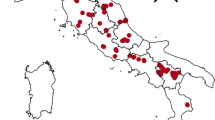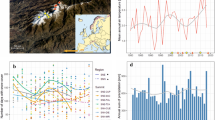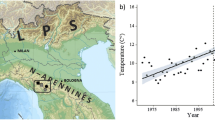Abstract
Diversity determinants have mostly been evaluated in high diversity areas, leaving behind regions with less species diversity such as drylands. Here we aim to analyze the patterns of plant diversity in tropical drylands in the southern Central Andes, and determine the importance of water, energy, and environmental heterogeneity as diversity determinants of the arid and semi-arid adapted flora. We examined the distribution of 645 native species from lowlands to 6000 m.a.s.l. in the north-western region of Argentina (NWA) and define hotspots of diversity within each NWA ecoregion. Diversity is concentrated in regions of middle elevation with intermediate values of water and energy, at the transition between arid and semi-arid regions. Furthermore, we showed that in tropical drylands energy input is as fundamental for plant diversity as water input is and, we found that the effects of these variables varied with elevation and, also with aridity. Water variables had the strongest effect on the flora in the arid high Andean ecoregions, where an increase in precipitation during the growing season stimulated species diversity. Energy only became more important than water when the arid adapted flora entered the low and semi-arid regions where energy increments reduce species diversity. Our analysis provides strong quantitative support for climate variables as the main determinants of plant diversity across different ecoregions of the southern Central Andes. Given the present climate change events, knowing how these variables affect the distribution of the arid adapted flora is crucial for planning strategies for achieve their present and future conservation.




Similar content being viewed by others
References
Aagesen L, Bena MJ, Nomdedeu S, Panizza A, López R, Zuloaga F (2012) Areas of endemism in the Southern Central Andes. Darwiniana 50:218–251
Anderson RP, Raza A (2010) The effect of the extent of the study region on GIS models of species geographic distributions and estimates of niche evolution: preliminary tests with montane rodents (genus Nephelomys) in Venezuela. J Biogeogr 37:1378–1393
Barthlott W, Mutke J, Rafiqpoor MD, Kier G, Kreft H (2005) Global centres of vascular plant diversity. Nova Acta Leopold 92:61–83
Bianchi AR, Yañez CE (1992) Las precipitaciones en el noroeste argentino. INTA, Salta
Blach-Overgaard A, Svenning JC, Dransfield J, Greve M, Balslev H (2010) Determinants of palm species distributions across Africa: the relative roles of climate, non-climatic environmental factors, and spatial constraints. Ecography 33:380–391
Bonkoungou EG (2003) Biodiversity in the drylands: challenges and opportunities for conservation and sustainable use. Challenge Paper. The Global Drylands Initatve, UNDP Drylands Development Centre, Nairobi
Boria RA, Olson LE, Goodman SM, Anderson RP (2014) Spatial filtering to reduce sampling bias can improve the performance of ecological niche models. Ecol Model 275:73–77
Brown AD, Placci LG, Grau HR (1993) Ecología y diversidad de las selvas subtropicales de la Argentina. In: Goin F, Goñi F (eds) Elementos de política ambiental. H. Cámara de Diputados, Buenos Aires, pp 215–222
Bucklin DN, Basille M, Benscoter AM, Brandt LA, Mazzotti FJ, Romañach SS et al (2015) Comparing species distribution models constructed with different subsets of environmental predictors. Divers Distrib 21:23–35
Cabrera AL (1976) Regiones fitogeográficas argentinas. Enciclopedia Argentina de Agricultura y Jardinería 2:1–85
Cabrera AL, Willink A (1973) Biogeografía de América latina. Monografía 13, Serie de Biología, Organización de Estados Americanos, Washington, DC
Castellanos A (1944) Los tipos de vegetación de la Republica Argentina. Monografías del Instituto de Estudios Geográficos. Universidad Nacional de Tucumán 4:66–94
CEPF Critical Ecosystem Partnership Fund (2015) Ecosystem Profile Technical Summary Tropical Andes Biodiversity Hotspot. NatureServe and EcoDecisión, p 53
Crisp MD, Laffan S, Linder HP, Monro A (2001) Endemism in the Australian flora. J Biogeogr 28:183–198
Distler T, Jorgensen PM, Graham A, Davidse G, Jimenez I (2009) Determinants and prediction of broad-scale plant richness across the Western Neotropics 1. Ann Mo Bot Gard 96:470–491
Dore MH (2005) Climate change and changes in global precipitation patterns: what do we know? Environ Int 31:1167–1181
Eiserhardt WL, Bjorholm S, Svenning JC, Rangel TF, Balslev H (2011) Testing the water–energy theory on American palms (Arecaceae) using geographically weighted regression. PLoS ONE 6:e27027
Elith J et al (2006) Novel methods improve prediction of species’ distributions from occurrence data. Ecography 29:129–151
Elith J, Phillips SJ, Hastie T, Dudík M, Chee YE, Yates CJ (2011) A statistical explanation of MaxEnt for ecologists. Divers Distrib 17:43–57
ESRI (2011) ArcGIS desktop: release 10. Environmental Systems Research Institute, CA
Ezcurra E (2006) Natural history and evolution of the world`s deserts. In: Ezcurra E (ed) Global deserts outlook. UNEP, Copenhagen, pp 2–26
FAO (1971) Food and Agriculture Organization of the United Nations. Mapa mundial de suelos. UNESCO, Paris 1971 (www.fao.org)
Field R, Hawkins BA, Cornell HV, Currie DJ, Diniz-Filho JA, Guégan JF, Kaufman DM, Kerr JT, Mittelbach GG, Oberdorff T, O’Brien EM, Turner JRG (2009) Spatial species-richness gradients across scales: a meta-analysis. J Biogeogr 36:132–147
Francis AP, Currie DJ (1998) Global patterns of tree species richness in moist forests: another look. Oikos 81:598–602
Francis AP, Currie DJ (2003) A globally consistent richness: climate relationship for angiosperms. Am Nat 161:523–536
Garreaud R, Vuille M, Clement AC (2003) The climate of the Altiplano: observed current conditions and mechanism of past changes. Paleogeogr Palaeoclimatol Palaeoecol 194:1–18
Gaston K (2000) Global patterns in biodiversity. Nature 405:220–227
Godoy-Bürki AC (2016) Efectos del cambio climático sobre especies de plantas vasculares del sur de los Andes Centrales: un estudio en el noroeste de Argentina (NOA). Ecol Austral 26:83–94
Godoy-Bürki AC, Ortega-Baes P, Sajama J, Aagesen L (2014) Conservation priorities in the Southern Central Andes: mismatch between endemism and diversity hotspots in the regional flora. Biodivers Conserv 23:81–107
Gonzales JA (2009) Climatic change and other anthropogenic activities are affecting environmental services on the Argentina Northwest (ANW). Earth Environ Sci 6:1–2
Graham CH, Elith J, Hijmans RJ, Guisan A, Townsend-Peterson A, Loiselle BA (2008) The influence of spatial errors in species occurrence data used in distribution models. J Appl Ecol 45:239–247
Grau RH, Gasparri IN, Aide MT (2005) Agriculture expansion and deforestation in seasonally dry forests of north-west Argentina. Environ Conserv 32:140–148
Hauman-Merck L, Burkart A, Parodi LR, Cabrera AL (1947) La vegetación de la Republica Argentina. In: Geografia de la Republica Argentina vol 8, pp 5–349
Hawkins BA et al (2003) Energy, water and broad scale geographic patterns of species richness. Ecology 84:3105–3117
Hijmans RJ, Cameron SE, Parra JL, Jones PG, Jarvis A (2005) Very high resolution interpolated climate surfaces for global land areas. Int J Climatol 25:1965–1978
Holmberg EL (1898) La flora de la Republica Argentina. Segundo Censo Rep Argent 1895(1):385–474
Hughes L (2003) Climate change and Australia: trends, projections and impacts. Austral Ecol 28:423–443
Ibisch PL, Beck SG, Gerkmann B, Carretero A (2003) Diversidad Biológica: Ecoregiones y ecosistemas. In: Ibisch P, Merida G (eds) Biodiversidad: La riqueza de Bolivia. Editorial FAN, Santa Cruz de la Sierra, pp 73–75
Izquierdo AE, Grau HR (2009) Agriculture adjustment, land-use transition and protected areas in North-western Argentina. J Environ Manag 90:858–865
Jorgensen PM, Ulloa Ulloa C, León B et al (2011) Regional patterns of vascular plant diversity and endemism. In: Herzog SK, Martínez R, Jørgensen PM, Tiessen H (eds) Climate change and biodiversity in the tropical andes. Inter-American Institute for Global Change Research, São José dos Campos, pp 192–203
Josse C et al (2003) Ecological systems of Latin America and the Caribbean: a working classification of terrestrial systems. NatureServe, Arlington
Kessler M, Grytnes JA, Halloy SR et al (2011) Gradients of plant diversity: local patterns and processes. In: Herzog SK, Martínez R, Jørgensen PM, Tiessen H (eds) Climate change and biodiversity in the tropical andes. Inter-American Institute for Global Change Research, São José dos Campos, pp 204–219
Kreft H, Jetz W (2007) Global patterns and determinants of vascular plant diversity. PNAS 104:5925–5930
Kumar S, Stohlgren TJ (2009) Maxent modelling for predicting suitable habitat for threatened and endangered tree Canacomyrica monticola in New Caledonia. J Ecol Nat Environ 1:94–98
Li L, Wang Z, Zerbe S, Abdusalih N, Tang Z, Ma M, Yin L, Mohammat A, Han W, Fang J (2013) Species richness patterns and water-energy dynamics in the Drylands of Northwest China. PLoS ONE 8:e66450
Lorentz PG (1876) Cuadro de la vegetación de la Republica Argentina. In: Napp R (ed) La Republica Argentina, Buenos Aires, pp 77–136
Luebert F, Weigend M (2014) Phylogenetic insights into Andean plant diversification. Front Ecol Evol 2:27
Martínez-Carretero E (1995) La Puna Argentina: delimitación general y división en distritos florísticos. Bol Soc Argent Bot 31:27–40
McFadden D (1979) Quantitative methods for analyzing travel behavior of individuals: some recent developments. In: Hensher DA, Stopher PR (eds) Behavioral Travel Modelling, Chapter 13. Groom Helm London, London, pp 279–318
Montgomery DC, Peck EA, Vining GG (2012) Introduction to Linear Regression Analysis, 5th edn. Wiley, New york
Morrone JJ (2006) Biogeographic areas and transition zones of Latin America and the Caribbean islands based on panbiogeographic and cladistic analyses of the entomofauna. Annu Rev Entomol 51:467–494
Morrone JJ (2014) Biogeographical regionalization of the Neotropical region. Zootaxa 3782:1–110
Moser D, Dullinger S, Englisch T et al (2005) Environmental determinants of vascular plant species richness in the Austrian Alps. J Biogeogr 32:1117–1127
Myers N, Mittermeier RA, Mittermeier CG, Da Fonseca GBA, Kent J (2000) Biodiversity hotspots for conservation priorities. Nature 403:853–858
Olson DM, Dinerstein E, Wikramanayake ED et al (2001) Terrestrial ecoregions of the World: a new map of life on Earth. BioSci 51:933–938
Parodi LR (1945) Las regiones fitogeográficas argentinas y sus relaciones con la industria forestal. In: Verdoorn F (ed) Plants and plant science in Latin America. Chronica Botanica Company, Waltham, pp 127–132
Pearson RG, Raxworthy CJ, Nakamura M, Peterson AT (2007) Predicting species distributions from small numbers of occurrence records: a test case using cryptic geckos in Madagascar. J Biogeogr 34:102–117
Peet R (1974) The measurement of species diversity. Annu Rev Ecol Syst 5:285–307
Pernetta AP (2014) Conserving dryland biodiversity. Biodiversity 15(2-3):237–238
Philips S, Dudik M (2008) Modeling of species distributions with Maxent: new extensions and a comprehensive evaluation. Ecography 31:161–175
Phillips S, Anderson R, Schapire R (2006) Maximum entropy modeling of species geographic distributions. Ecol Model 190:231–259
Pinheiro J, Bates D, DebRoy S, Sarkar D, Team RC (2012) nlme: linear and nonlinear mixed effects models. R package version 3, 103. http://CRAN.R-project.org/package=nlme
Radosavljevic A, Anderson RP (2014) Making better Maxent models of species distributions: complexity, overfitting and evaluation. J Biogeogr 41:629–643
Ribichich AM (2002) El modelo clásico de la fitogeografía de Argentina: un análisis crítico. Interciencia 27:669–675
Ricklefs RE, Latham RE, Qian H (1999) Global patterns of tree species richness in moist forests: distinguishing ecological influences and historical contingency. Oikos 86:369–373
Roig FA, Roig-Juñent S, Corbalán V (2009) Biogeography of the Monte Desert. J Arid Environ 73:164–172
Safriel U, Adeel Z (2005) Dryland systems. In: Hassan R, Scholes R, Ash N (eds) Ecosystems and human well-being, current state and trends, vol 1. Island Press, Washington, pp 625–658
Shcheglovitova M, Anderson RP (2013) Estimating optimal complexity for ecological niche models: a jackknife approach for species with small sample sizes. Ecol Model 269:9–17
Stein A, Gerstner K, Kreft H (2014) Environmental heterogeneity as a universal driver of species richness across taxa, biomes and spatial scales. Ecol Lett 17:866–880
Trabucco A, Zomer RJ (2009) Global aridity index (global-aridity) and global potential evapo-transpiration (Global-PET) Geospatial Database. CGIAR
UNEP (2006) Don’t desert drylands! Facts about deserts and desertification. www.unep.org
Versieux LM, Wendt T (2007) Bromeliaceae diversity and conservation in Minas Gerais state, Brazil. Biodivers Conserv 16:2989–3009
Vides-Almonacid R, Ayarde H, Scrocchi GJ, Romero F, Boero C, Chani JM (1998) Biodiversidad de Tucumán y el Noroeste Argentino. Opera Lilloana, pp 43–89
Villagrán C, Arroyo MK, Marticorena C (1983) Efectos de la desertización en la distribución de la flora andina de Chile. Rev Chil Hist Nat 56:137–157
Whittaker RJ, Nogués-Bravo D, Araújo MB et al (2007) Geographical gradients of species richness: a test of the water-energy conjecture of Hawkins (2003) using European data for five taxa. Glob Ecol Biogeogr 16:76–89
Wieczorek J, Guo Q, Hijmans RJ (2004) The point-radius method for georeferencing locality descriptions and calculation associated uncertainty. Int J Geogr Inf Sci 18:745–767
Wisz MS, Hijmans RJ, Li J, Peterson AT, Graham CH, Guisan A (2008) Effects of sample size on the performance of species distribution models. Divers Distrib 14:763–773
Young KR, Ulloa Ulloa C, Luteyn JL, Knapp S (2002) Plant evolution and endemism in Andean South America: an introduction. Bot Rev 68:4–21
Zuloaga FO, Morrone O, Rodríguez D (1999) Análisis de la biodiversidad en plantas vasculares de la Argentina. Kurtziana 27:17–167
Zuloaga FO, Morrone, O, Belgrano MJ (2008) Catálogo de las Plantas Vasculares del Cono Sur. Monogr Syst Bot Mo Bot Gard 107:609–967. (http://www2.darwin.edu.ar)
Zuur AF, Leno EN, Walker NJ, Saveliev AA, Smith GM (2009) Mixed effects models and extensions in ecology with R. Springer, New York, p 574
Author information
Authors and Affiliations
Corresponding author
Additional information
Communicated by Francis Brearley.
Electronic supplementary material
Below is the link to the electronic supplementary material.
Rights and permissions
About this article
Cite this article
Godoy-Bürki, A.C., Biganzoli, F., Sajama, J.M. et al. Tropical high Andean drylands: species diversity and its environmental determinants in the Central Andes. Biodivers Conserv 26, 1257–1273 (2017). https://doi.org/10.1007/s10531-017-1311-2
Received:
Revised:
Accepted:
Published:
Issue Date:
DOI: https://doi.org/10.1007/s10531-017-1311-2




